Virtual reality offers a powerful way to boost cognitive health by immersing you in engaging, realistic environments that target functions like attention, memory, and spatial skills. It enhances motivation and makes training enjoyable, encouraging consistent use. VR can mimic real-world tasks such as shopping or navigation, helping you transfer skills to daily life. If you keep exploring, you’ll discover how VR technology continues to evolve for personalized, effective cognitive support.
Key Takeaways
- VR provides immersive, multisensory environments that enhance motivation and engagement in cognitive training for older adults.
- It targets specific cognitive functions such as attention, working memory, and spatial orientation with real-world transfer benefits.
- Realistic virtual scenarios of daily activities support ecological validity and skill transfer for instrumental activities of daily living.
- Adaptive VR systems aim to personalize difficulty levels, but require development of reliable challenge assessment tools.
- Barriers like cost and digital literacy need addressing to improve accessibility and maximize VR’s benefits for cognitive stimulation.
Understanding Virtual Reality and Its Role in Cognitive Health
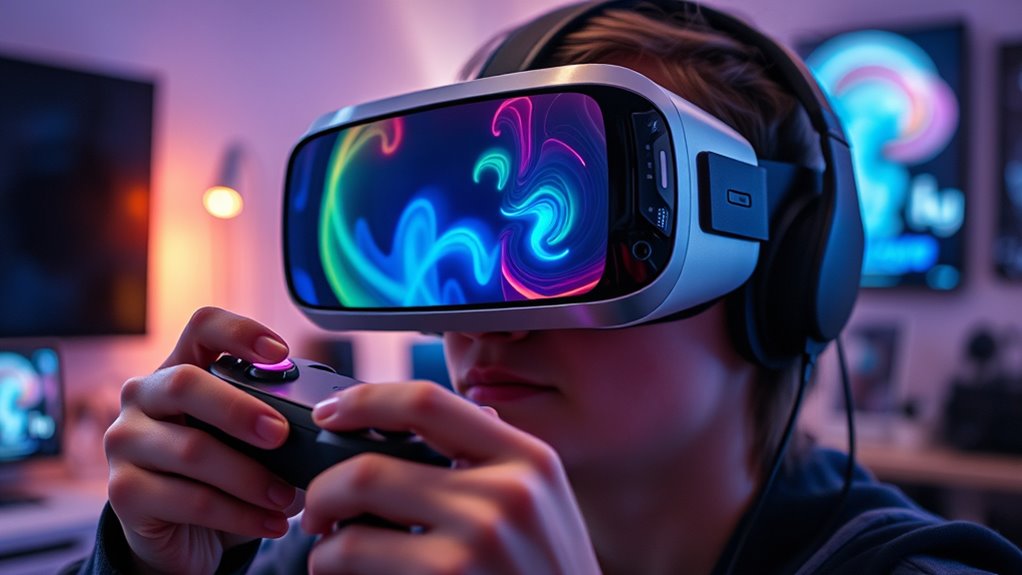
Virtual Reality (VR) immerses you in computer-generated environments that can mimic real-world settings or offer entirely new experiences. This technology actively involves you in immersive environments where your movements and interactions are tracked precisely. By doing so, VR enhances cognitive stimulation through engaging, realistic scenarios that promote focus and attention. Additionally, using productivity tools can help you maximize your time in these immersive experiences.
Whether using desktop setups, head-mounted displays, or large screens, VR provides varying levels of immersion, making it adaptable to different needs. The sense of presence and embodiment in these environments increases motivation and engagement during cognitive tasks.
Additionally, VR’s ability to measure behavioral data allows for detailed monitoring and personalized adjustments. This combination of immersion and precise feedback makes VR a powerful tool for supporting cognitive health and training. Furthermore, the integration of Intelligent Tutoring Systems (ITS) in VR applications can further enhance personalized learning experiences and cognitive engagement.
Key Cognitive Functions Targeted by VR-Based Interventions

VR-based interventions are designed to target a range of key cognitive functions to improve mental agility and daily functioning. Virtual reality training focuses on enhancing cognitive functions such as attention, working memory, and cognitive flexibility. Many programs incorporate neuropsychological tasks like n-back and Stroop exercises, making training engaging through gamified activities. The father-daughter bond is a crucial aspect that can inspire emotional engagement during these cognitive training sessions, as positive relationships often enhance learning. Recent advancements in technology have allowed for the development of vibe coding techniques that can tailor VR experiences to individual cognitive needs. Additionally, it is important to note that regular prenatal check-ups can significantly enhance cognitive health during pregnancy, ensuring both mother and baby are thriving.
Spatial orientation training in VR environments uses multisensory cues to boost navigation skills and environmental awareness. These interventions aim to transfer cognitive gains to real-world settings by simulating daily tasks like shopping or household chores. Research shows VR can lead to small to moderate improvements across multiple cognitive domains, especially in older adults with mild cognitive impairment, making it a promising tool for targeted cognitive stimulation. Additionally, studies suggest that immersive experiences, similar to ice cream consumption trends, can enhance user engagement and retention during cognitive training sessions. Incorporating elements from best podcasts of 2024 can further enrich the content and provide diverse stimuli for cognitive enhancement.
Benefits of Immersive Environments for Older Adults
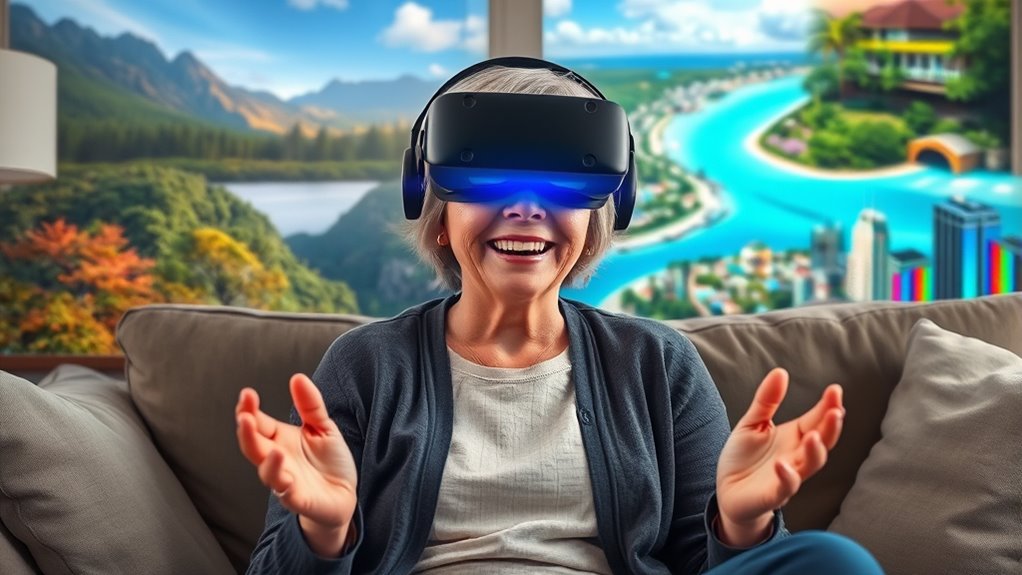
Immersive environments in virtual reality create realistic, multisensory experiences that considerably boost engagement and motivation among older adults during cognitive training. These environments facilitate natural interaction and embodiment, which helps maintain attention and encourages sustained participation. Studies show that full VR systems improve the transfer of cognitive benefits to real-world tasks, making training more practical. Additionally, immersive VR’s ecological validity allows for personalized scenarios—like navigating virtual supermarkets—that target multiple cognitive domains effectively. Older adults tend to prefer this format, experiencing higher enjoyment and adherence compared to traditional methods. Understanding the impact of immersive environments can be summarized as follows:
| Feature | Benefit | Impact |
|---|---|---|
| Multisensory experiences | Increased engagement | Better cognitive outcomes |
| Personalization | Relevant, real-life scenarios | Improved transferability |
| Natural interaction | Enhanced motivation | Sustained cognitive training |
Furthermore, engaging in multisensory experiences can help improve cognitive function by providing a richer context that resonates with older adults’ lived experiences. Incorporating elements of high refresh rates can further enhance the realism of virtual scenarios, making them more engaging for older users. Additionally, utilizing lucid dreaming techniques can promote mental flexibility, aiding older adults in adapting their cognitive strategies during training. Creating environments that mimic backyard greenhouses can also stimulate cognitive processes by evoking familiar gardening tasks that many older adults enjoy. To further emphasize the significance of emotional depth, it is essential to acknowledge that engaging narratives in VR can also evoke feelings similar to those found in beloved animated films.
Comparing VR Therapy With Conventional Cognitive Training
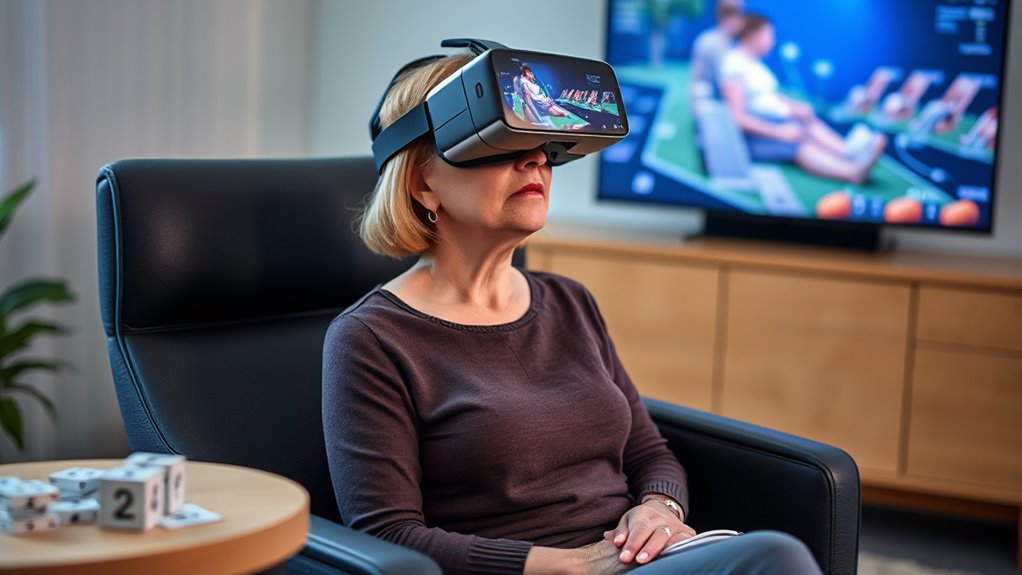
While traditional cognitive training methods have long been used to support cognitive health in older adults, recent evidence suggests that VR therapy offers comparable, if not enhanced, benefits. Systematic reviews show that VR therapy for cognitive stimulation is at least as effective as conventional cognitive training in improving functions like memory, attention, and executive skills.
Particularly, semi-immersive VR systems demonstrate small to moderate effect sizes (around 0.29 to 0.42), similar to traditional approaches. VR-based interventions also provide ecological and adaptive advantages, creating personalized, realistic environments that traditional methods lack. Additionally, the use of traditional butter churns in culinary activities can enhance cognitive engagement by stimulating sensory experiences. Engaging in high vibrational energy activities can also contribute to cognitive well-being. Furthermore, incorporating antioxidant-rich berries into one’s diet has been linked to enhanced memory and brain health, supporting overall cognitive function. Quality Assurance practices in the development of VR therapy applications can significantly enhance user experience and effectiveness. Moreover, incorporating penetration testing techniques in the evaluation of VR applications could help identify and address vulnerabilities that may hinder user engagement and safety.
Randomized controlled trials indicate that VR therapy can slightly outperform standard cognitive training in certain domains. However, further research with larger, more consistent samples is needed to confirm VR therapy’s full potential relative to conventional methods.
Designing Effective VR Activities for Real-World Skills

When designing VR activities for real-world skills, focus on mimicking daily tasks like shopping or cooking to promote skill transfer. Guarantee the environments are realistic and safe, allowing users to practice without risk. Incorporate multisensory feedback and adaptive challenges to keep engagement high and support natural interactions. Additionally, ensure the gear shifting techniques are included to enhance coordination and cognitive engagement during tasks that require physical actions. To maximize effectiveness, consider incorporating specialized spray tips that can enhance precision in VR simulations requiring fine motor skills.
Mimicking Daily Tasks
Designing effective VR activities that mimic daily tasks requires creating realistic environments and engaging multiple senses to replicate the physical and cognitive challenges of real-world activities. By integrating virtual environments that simulate everyday settings, you can enhance the ecological validity of cognitive training. These activities often focus on instrumental activities of daily living (iADLs), such as shopping or medication management, to target essential skills for independence. Incorporating multisensory feedback and body movements helps replicate the demands of real tasks, promoting better transfer of skills. Additionally, utilizing principles from French Press Operation can inspire the design of activities that emphasize the importance of technique and precision in daily tasks.
To ensure effectiveness, it’s essential to include elements that encourage strong suction power for enhanced interaction during the VR experience. For instance, incorporating costume elements from popular franchises can engage users and enhance their motivation to participate. Validated through neuropsychological principles, these scenarios improve executive functions, spatial orientation, and memory. Achieving the right balance of immersion, challenge, and safety is key to ensuring engagement and measurable improvements. Additionally, incorporating elements from water parks can provide a fun context for practicing social interactions and decision-making skills in a virtual setting. Furthermore, using an MVP approach allows for rapid testing and iteration of VR activities to ensure they meet user needs effectively.
Ensuring Realism and Safety
Creating realistic and safe VR activities hinges on developing high-fidelity environments that accurately replicate everyday settings, such as supermarkets or kitchens. Achieving realism in virtual reality involves detailed visuals and naturalistic interactions, like body movements and environmental cues, to foster immersion and embodiment.
Safety is equally critical; it requires minimizing adverse effects such as cybersickness by choosing high-quality headsets with reduced latency and limiting movement within the environment. Incorporating real-time monitoring and adaptive difficulty keeps activities challenging yet safe, preventing frustration or fatigue.
Rigorous testing and validation ensure the environment is hazard-free and suitable for older adults or cognitively impaired users. Balancing realism with safety guarantees that VR exercises effectively promote real-world skill transfer while prioritizing user well-being. Additionally, drawing inspiration from Halloween night traditions can enhance the thematic elements of VR environments, making them more engaging and relatable to users.
Challenges in Developing Adaptive and Personalized VR Programs
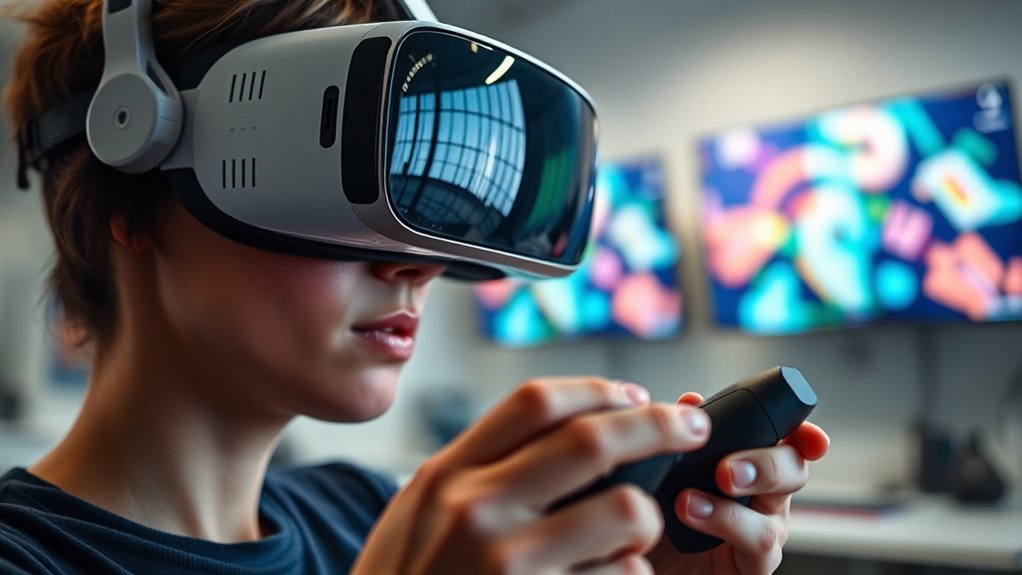
Developing adaptive and personalized VR programs presents significant challenges, primarily due to the difficulty in accurately measuring user challenge levels in real-time. For effective challenge assessment, you need reliable metrics that can dynamically adjust difficulty without causing frustration or boredom.
Currently, there’s a lack of standardized guidelines and an extensive framework integrating cognitive theories like flow and load, which hampers consistent design. Additionally, ensuring responsiveness to individual variability remains complex, especially when integrating physiological and behavioral data for true personalization.
Without validated properties defining effective VR rehabilitation games, creating adaptive VR environments becomes more difficult. Key challenges include:
- Developing reliable challenge assessment tools
- Establishing standardized guidelines for personalization
- Integrating physiological data for dynamic adjustments
Evidence From Recent Studies on Vr’S Impact on Cognitive Decline
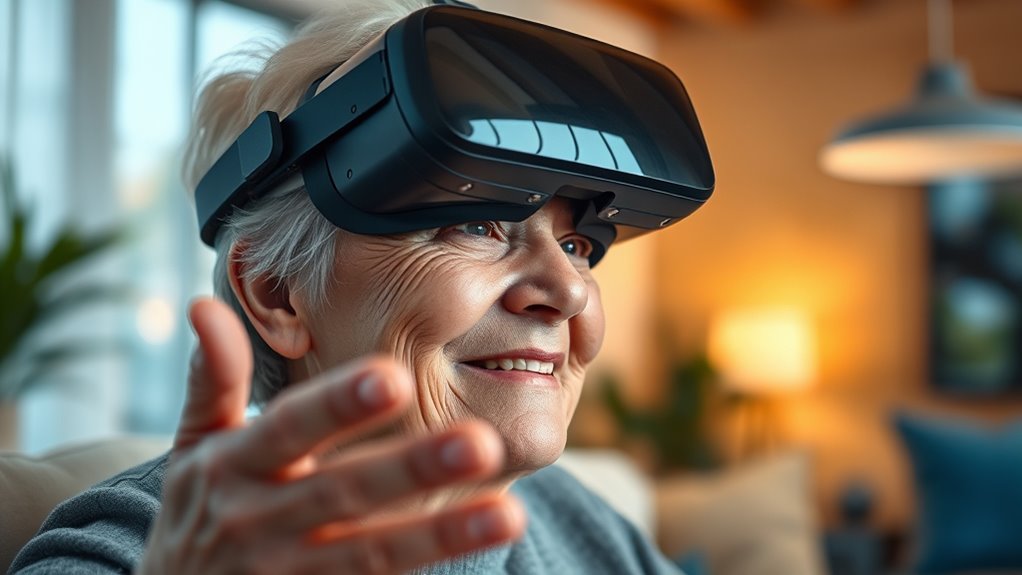
Recent studies show that VR can offer meaningful improvements in attention, memory, and executive functions for older adults with cognitive decline.
You’ll notice that semi-immersive systems often produce higher benefits than fully immersive ones, especially in real-life applications.
These findings suggest VR’s potential for ecological rehabilitation, helping users perform daily tasks more independently.
VR’s Cognitive Benefits
Emerging evidence shows that virtual reality (VR) offers tangible cognitive benefits for older adults experiencing mild cognitive impairment (MCI) or dementia. Recent studies reveal that VR-based cognitive interventions produce small to medium effects (ES=0.29), with semi-immersive systems showing higher efficacy (ES=0.37) in improving attention, memory, and visuospatial skills.
These interventions also promote ecological and adaptive advantages, helping you transfer skills to daily activities. Meta-analyses indicate moderate improvements in cognition (ES=0.42), especially in executive functions and spatial orientation.
VR can be as effective as traditional cognitive rehab, often increasing motivation and adherence. Overall, virtual reality provides a promising tool to support cognitive health in older adults.
- Improved attention, memory, and visuospatial skills
- Transfer of benefits to daily activities
- Increased motivation and engagement
Immersion Level Effects
Have you wondered how the level of immersion in virtual reality influences its effectiveness for cognitive decline? Recent studies show that semi-immersive VR systems often provide larger cognitive benefits than fully immersive setups, with effect sizes around 0.37 compared to 0.03.
Remarkably, higher immersion levels don’t always lead to better outcomes; some research favors semi-immersive environments for cognitive improvements. Meta-analyses reveal small-to-medium effects overall, with semi-immersive VR contributing more notably.
This level of immersion enhances ecological validity and user engagement, which helps with transfer of training effects in older adults with MCI. Additionally, semi-immersive VR is often preferred for comfort and reduced cybersickness, boosting motivation and adherence, ultimately amplifying cognitive benefits.
Ecological Rehabilitation Potential
Studies demonstrate that VR-based cognitive training substantially enhances real-world functioning by simulating daily activities, which increases ecological validity for older adults with MCI and dementia. Virtual reality’s immersive environments, like virtual supermarkets and home settings, help transfer skills learned during training to everyday tasks, supporting greater independence.
Research shows that VR interventions targeting instrumental activities of daily living (iADLs) produce moderate improvements in cognitive and functional outcomes, often exceeding traditional therapies. The multisensory, body-related interaction in VR increases engagement and motivation, leading to more naturalistic cognitive rehabilitation.
These benefits suggest VR’s strong potential for ecological rehabilitation, enabling older adults to apply learned skills effectively in real-life contexts and improving their quality of life.
- Transfer of training to daily tasks
- Increased engagement through multisensory interaction
- Moderate improvements in cognition and independence
Enhancing Engagement and Motivation Through Virtual Experiences

Virtual experiences in VR can substantially boost engagement and motivation by adapting to each user’s needs and preferences. Immersive environments create a sense of presence that encourages users to stay focused and attentive.
Virtual VR experiences enhance engagement by fostering focus and presence through immersive, adaptive environments.
Dynamic Difficulty Adjustment (DDA) tailors challenges in real-time, keeping tasks ideally engaging without causing frustration or boredom. Incorporating multisensory feedback enhances immersion, making cognitive training more compelling and emotionally engaging.
Multiplayer VR experiences foster social interaction, which increases motivation and promotes adherence, especially among elderly users. Gamified elements like rewards and achievement metrics provide tangible goals, further motivating users to participate regularly.
High levels of immersion and personalization make the experience more emotionally resonant, leading to sustained engagement and improved training outcomes.
Addressing the Digital Divide in VR-Based Cognitive Care
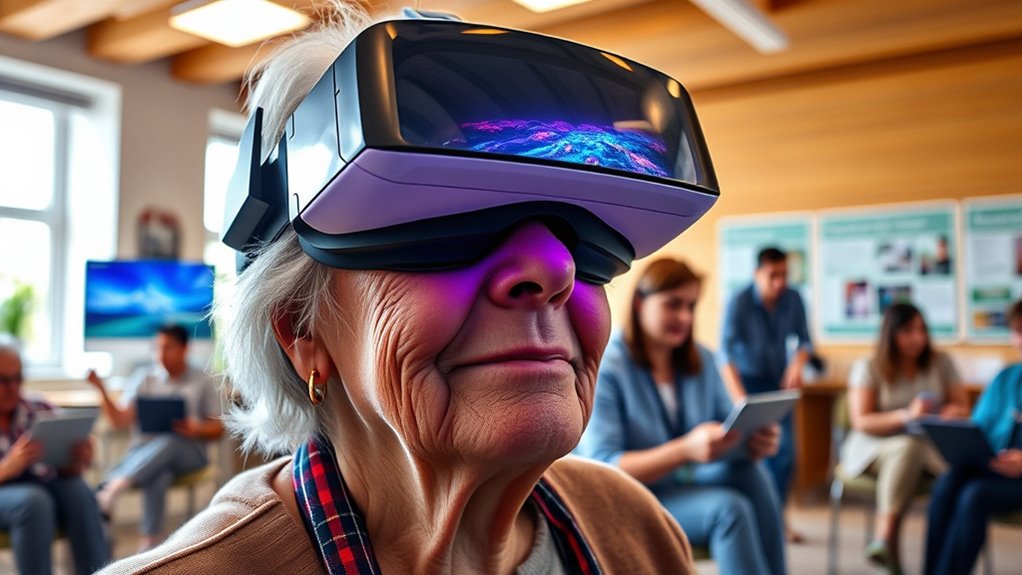
Although virtual reality offers promising opportunities for cognitive care, the digital divide considerably limits its accessibility for many older adults. Many seniors face barriers like low digital literacy, high costs, and limited infrastructure, which hinder their participation in VR-based interventions.
This divide reduces equitable access to potentially beneficial cognitive stimulation. To address this, efforts focus on creating affordable VR options, guaranteeing ease of use, and providing tailored training. Improving internet connectivity and device availability is also vital for closing gaps across socioeconomic groups.
By prioritizing these strategies, you can help guarantee that all older adults, regardless of background, benefit from VR’s cognitive health potential.
- Developing affordable, user-friendly VR systems
- Offering tailored digital literacy training
- Ensuring equitable device and internet access
Future Directions for Research and Practical Applications
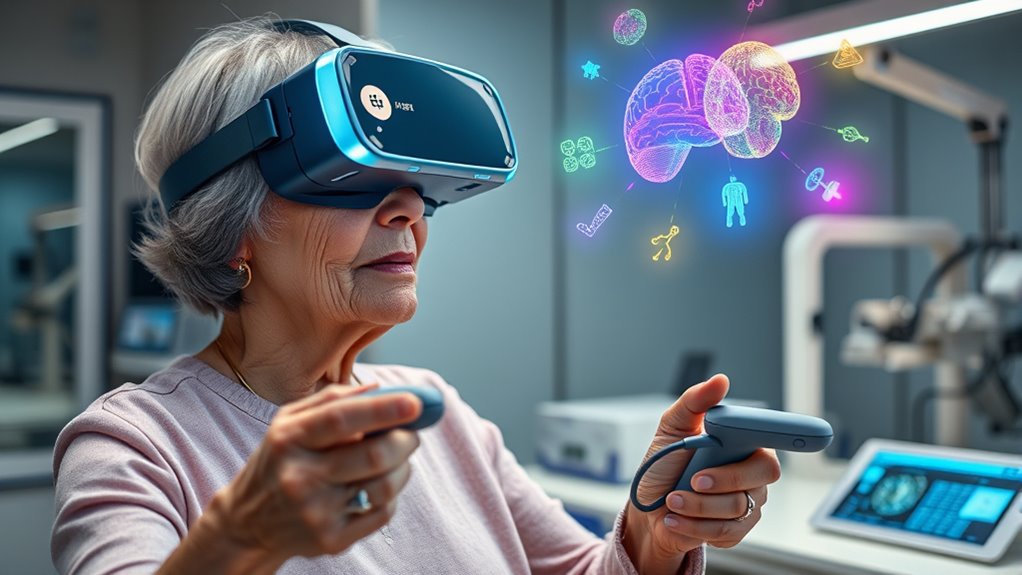
Advancing the field of VR for cognitive stimulation requires focused research on adaptive difficulty, ensuring personalized and engaging experiences for older adults. Developing standardized guidelines for difficulty adjustments will help tailor challenges to individual needs, maintaining motivation.
Incorporating physiological metrics like heart rate and galvanic skin response can enable real-time difficulty tuning, enhancing ecological validity.
Expanding multimodal VR systems with multiplayer and social interaction features can boost motivation and adherence, making interventions more enjoyable.
Longitudinal assessment is essential to determine whether these VR interventions produce lasting benefits in daily functioning and quality of life.
Integrating cognitive theories such as flow, load, and feedback into VR design will optimize the challenge-skill balance, maximizing therapeutic outcomes and ensuring sustained engagement over time.
Frequently Asked Questions
Does VR Stimulate Your Brain?
Yes, VR stimulates your brain by providing multisensory experiences that activate various neural regions involved in cognition, attention, and memory.
When you engage with VR tasks tailored to specific skills, it directly stimulates the related neural circuits. The immersive and engaging nature of VR keeps you motivated, encouraging neural connections to strengthen.
Over time, this stimulation can lead to measurable changes in brain activity, enhancing your learning, memory, and overall cognitive function.
Is VR Good for Dementia Patients?
You’re wondering if VR benefits dementia patients. The evidence suggests it can be quite helpful by making therapy more engaging and motivating.
When you use VR, you provide immersive environments that may improve cognitive functions like memory and spatial awareness.
Patients often enjoy these experiences, which can lead to better compliance.
While promising, keep in mind that more research is needed to confirm long-term benefits and ideal ways to use VR in dementia care.
What Is Virtual Reality CBT?
Imagine you’re exploring a virtual park to confront your fears—that’s what Virtual Reality Cognitive Behavioral Therapy (VR-CBT) does. It uses immersive VR environments to deliver mental health treatments, like exposure therapy for phobias or anxiety.
You engage in personalized scenarios, and your reactions are monitored in real time, helping therapists tailor interventions. VR-CBT makes therapy more engaging and effective, providing a safe space to work through challenges.
Is Virtual Reality Good for ADHD?
You might wonder if virtual reality is good for ADHD. It can be quite effective because it offers immersive, engaging environments that capture your attention and make therapy more motivating.
VR-based programs help improve focus, reduce impulsivity, and strengthen executive functions through gamified tasks.
While results look promising, keep in mind that long-term benefits and ideal designs are still being researched, so it’s best to consult a professional for personalized advice.
Conclusion
As you explore virtual reality for cognitive stimulation, you’ll find it offers more than just engaging experiences—it’s shaping the future of cognitive health. Sometimes, it’s surprising how immersive environments can boost memory, attention, and motivation, even in older adults. While challenges remain, the coincidence of technology’s rapid growth and our need for effective interventions suggests VR could become a essential tool. Embrace these innovations, and you might discover new ways to support cognitive well-being when you least expect it.










